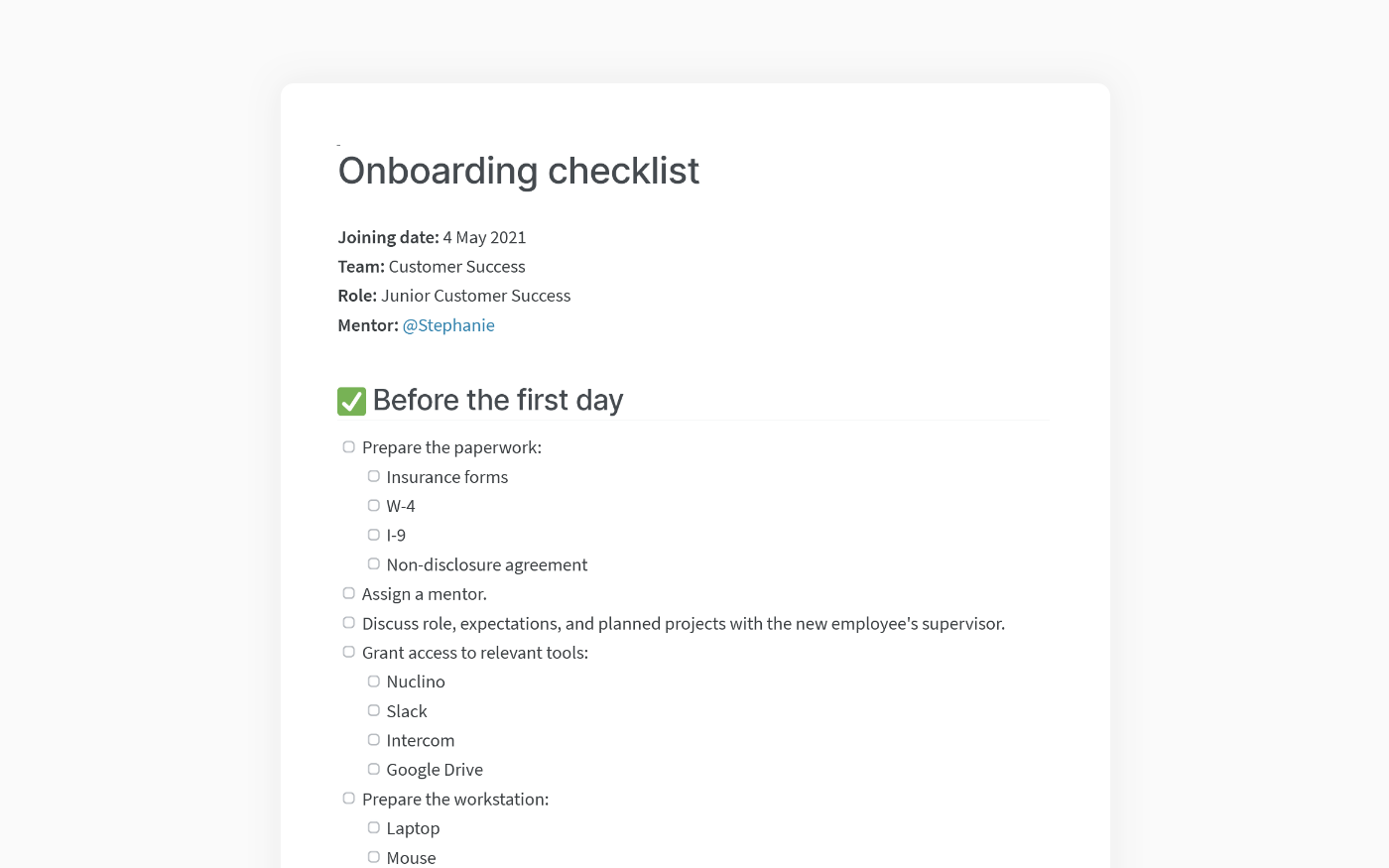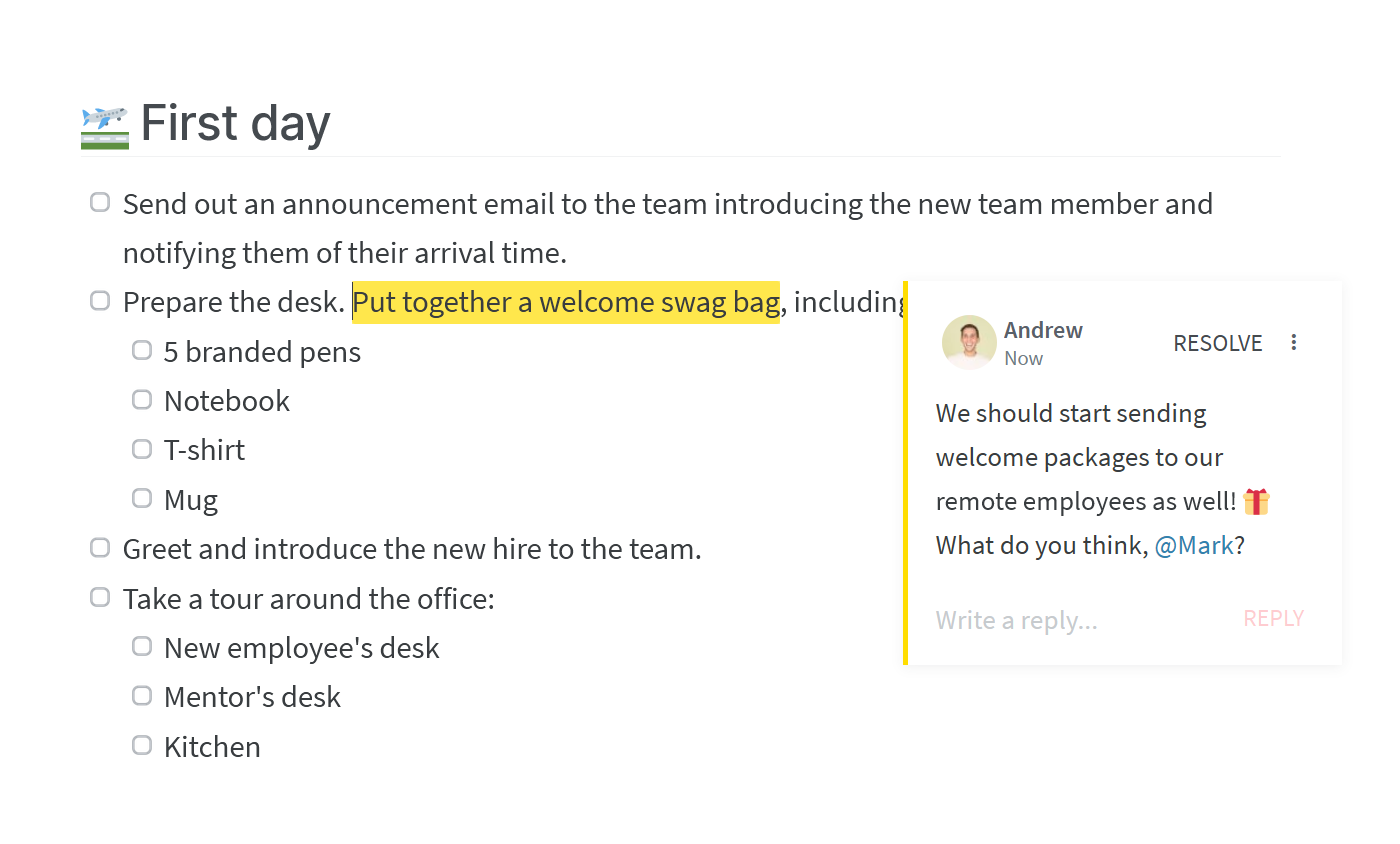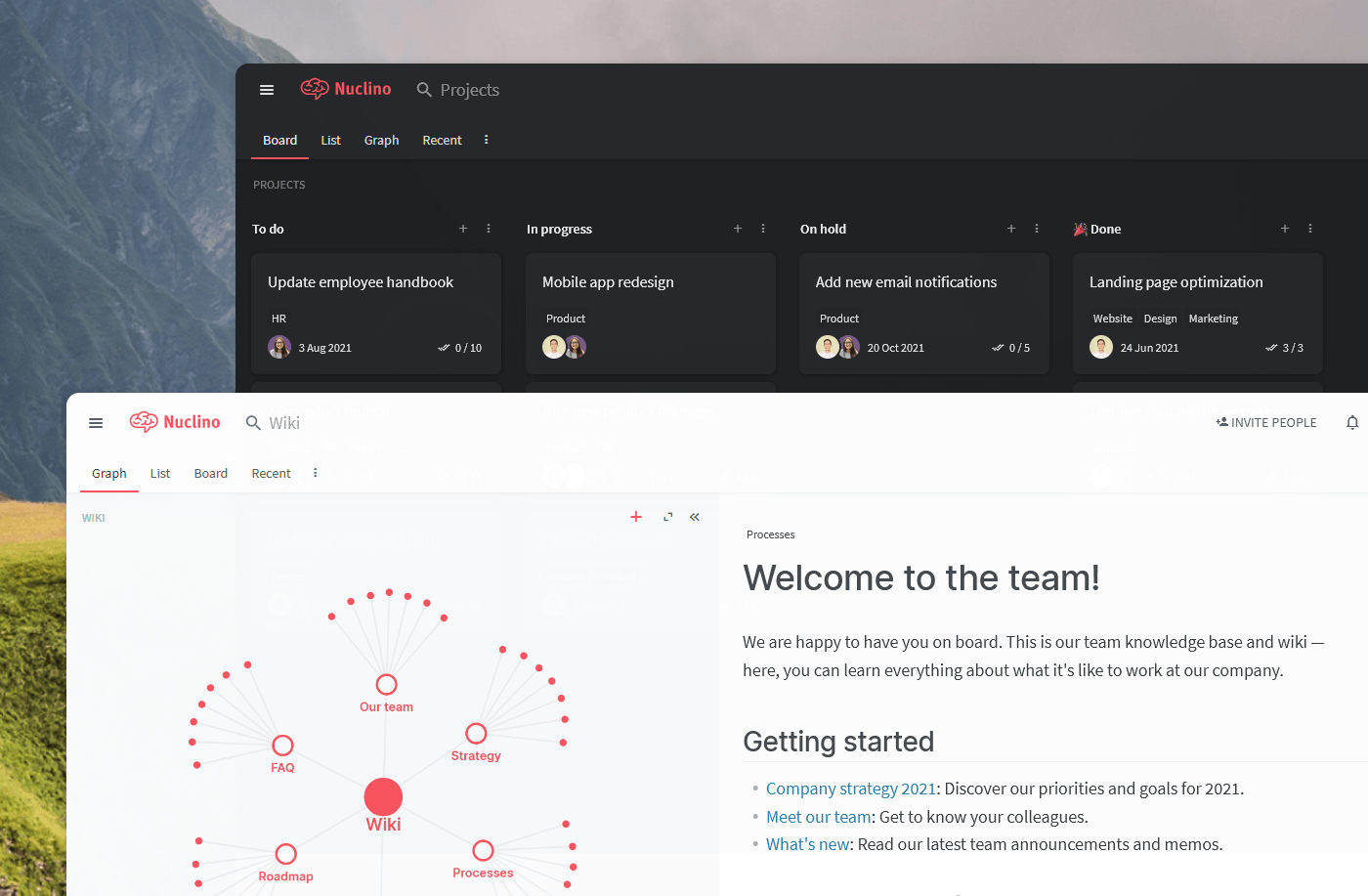New Employee Onboarding Checklist
Streamline your onboarding process and ensure that your new team members' first weeks go without a hitch.
The long, arduous recruitment process is finally over. You’ve whittled down the candidates to find that one perfect individual who ticks all the boxes on your list. They are surely going to be a great addition to the team.
Time to pat yourself on the back and get back to business as usual, right?
Alas, studies say that around 20% of employees quit within the first 45 days of starting a new job. With the cost of hiring a new employee averaging around $65,000 (use this employee cost calculator to better understand the associated expenses), the real work of the HR manager begins after the new hire signs the contract.
The first step towards successfully engaging and retaining new employees is creating a thorough new employee onboarding checklist.
- What is an employee onboarding checklist?
- What to include in your new hire onboarding checklist
- Onboarding new employees with Nuclino
What is an employee onboarding checklist?
A new employee onboarding checklist is a comprehensive list of all the tasks that need to be completed in order for the new employee to get up to speed. If you want to retain your top talent, good employee onboarding is essential. And like all first impressions, you only have one shot to get it right.

Successfully preparing an employee for their new role is never an easy task, even when the new hire is an experienced professional. From getting all the paperwork in order to clearly communicating the expectations of the job, many things can slip through the cracks.
A new hire onboarding checklist is there to prevent this from happening and help you make sure you don’t miss anything crucial during your new employee's first few weeks on the job. It streamlines your employee onboarding process and helps your new teammates hit the ground running when you welcome them to the team.

New employee onboarding checklist in Nuclino
What to include in your checklist
A new employee onboarding checklist is more than just a list of forms to fill out and sign. While getting all the necessary paperwork done is certainly an important part of onboarding, there is a lot more to it.
The exact list of items you would need to include in your onboarding checklist depends on your company and the local legal requirements you may have in your country. However, there are several important topics you would likely want to cover regardless.
Before the first day
Onboarding doesn't start on your new employee's first day. It starts the moment they accept the job offer. To make sure everything is in order by the time your new colleague enters your office, create a checklist listing all the things that need to be done before their first day.
Such checklists usually include the following items:
Paperwork. Perhaps the least exciting but one of the most important parts of the onboarding process is the paperwork. It needs to be prepared by you and signed by the new employee. In addition to the contract, it usually includes such documents as insurance forms, NDAs, I-9 forms, and so on. The full list may be longer or shorter, depending on your company. Using an eSign tool or an online notary service can help you handle all this legal paperwork in a fast and secure way.
Accounts & tools. Your employee will likely need access to many of the digital tools your company is using. Such tools may include your email client, project management software, internal communications apps, and many more depending on the new employee's role. Getting everything set up beforehand will save them the trouble of spending their first day fumbling with passwords.
Workstation & hardware. Prepare the employee's workstation before they arrive to avoid any delays on their first day. In case they will need any particular devices or supplies for their work – a business phone, a printer, a headset, and so on – make sure they are ready.
Guides & reading materials. Joining a new company is challenging, even for seasoned professionals. It can take weeks before the new employee becomes familiar with all of your internal workflows and turns into a fully productive member of the team. Sharing some helpful guides and training materials with the employee in advance can make this transition much smoother and minimize shoulder taps on their first day. Make sure to share your employee handbook with them and consider giving them access to your internal knowledge base or company intranet portal, if you have one.
Supervisor & mentor. During your new employee's orientation period, they will likely need guidance. Make sure that a supervisor or a mentor would be available to work closely with them, clarifying their responsibilities and expectations, setting their goals and KPIs, and helping them navigate your company's HR policies, workflows, and facilities.

Onboarding checklist to complete before the first day (created in Nuclino)
On the first day
Your new team member decided to switch jobs because they were convinced your company is better. And you know what? They’re totally right. Reaffirm that belief by making sure their first day goes without a hitch.
Often a new employee will arrive during a busy working week. Clear your schedule and make the new employee the number one priority for the day.
This part of the new employee onboarding checklist usually covers the orientation program and includes the following items:
Team introduction. Don't let paperwork and logistics be their first impression. Start by warmly welcoming the new hire and introducing them to the team. Make sure to notify your colleagues about their arrival in advance, so they can find the time to properly greet them.
Office tour. Take your employee on a tour around the office. Let them know where all the important areas and facilities are, including the bathroom and the kitchen. Show them to their desk and make sure there is a swag bag waiting for them, filled with branded pens, notebooks, a t-shirt, or a mug.
1-on-1 with the supervisor or mentor. After your new employee has settled, invite them to a 1-on-1 meeting with their supervisor or mentor so you can give them an introduction into your company culture, clarify your expectations for them, and answer any questions they may have about their new role.
Team lunch. Allow your new hire to get to know their new team by taking them out to lunch together. Avoid discussing work – this should be an opportunity to get to know each other personally in an informal setting.

Onboarding checklist to complete on the first day (created in Nuclino)
First week
During your new employee's first week, it's time to help them settle in their new role. Provide them with small but interesting challenges so they can gradually learn their new responsibilities. It's also a good time to clarify your long-term expectations.
This final section of the new hire onboarding checklist typically includes:
First project. Once your new employee has gotten to know their team and feels comfortable in the workplace, you should be ready to assign their first project. This will ensure they learn the job hands-on and feel valuable to the company, rather than doing menial tasks.
Long-term goals & expectations. Let your employee know where they fit into your company's vision and mission. Explain to them why their work is meaningful and make them feel involved. At the same time, communicate all the personal growth opportunities your company can offer to the employee.
Check-in meetings. Regular check-in meetings are needed to ensure that all expectations are met and all concerns are addressed on both sides. It's one of the best employee retention techniques at your disposal. Make sure to schedule these meetings during your new employee's first months on the job.
Onboarding new employees with Nuclino
Until now, we focused on the checklists intended mainly for the HR team and the hiring manager. However, onboarding checklists are also great for guiding your employee during their first weeks. And the checklist you share with your new colleague on their first day should be more than a list of tasks. Instead, create a proper welcome page that contains everything they need to know and do on their first day.
The best place to store it is in your company wiki. This will give them access to all your internal company knowledge and let them explore it at their own pace.
After all, your new employee will likely have a lot of questions on their first day. Most of them are simple and repetitive: How does the printer work? Where do I submit expenses for approval? What's the vacation policy? You can let them tap on people's shoulders, or you can allow them to find answers to most of these questions themselves, helping them get up to speed faster.
If you don't have a company wiki yet, this is reason enough to create one. There are many wiki tools to choose from – Nuclino is one of them. Give it a try by creating an account and putting together your very first employee onboarding checklist.
But regardless of the tool you choose, creating a new employee onboarding checklist is sure to pay off. It's one of the most straightforward ways to make your new employees feel at home and help them get up to speed faster. You may not get it perfectly right the first time, but make sure to continuously iterate, evaluating the steps that do and don't work for you, and adding the missing details.
And if you are looking for an easier and faster way to get started with onboarding checklists, we've got you covered – simply copy this onboarding checklist template into your Nuclino workspace and modify it to fit your onboarding process.
Nuclino: Your team's collective brain

Nuclino brings all your team's knowledge, docs, and projects together in one place. It's a modern, simple, and blazingly fast way to collaborate, without the chaos of files and folders, context switching, or silos.
Create a central knowledge base and give your team a single source of truth.
Collaborate in real time or asynchronously and spend less time in meetings.
Manage and document your projects in one place without losing context.
Organize, sort, and filter all kinds of data with ease.
Integrate the tools you love, like Slack, Google Drive, Figma, Lucidchart, and more.
Ready to get started?
